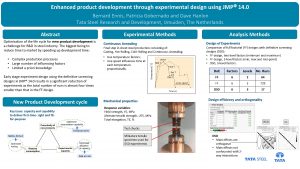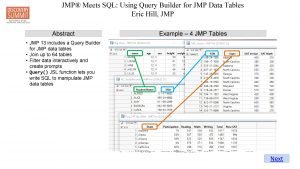Enhanced product development through experimental design using JMP


- Slides: 2

Enhanced product development through experimental design using JMP 14. 0 Bernard Ennis, Patricia Gobernado and Dave Hanlon Tata Steel Research and Development, IJmuiden, The Netherlands Abstract Optimisation of the life cycle for new product development is a challenge for R&D in steel industry. The biggest being to reduce time to market by speeding up development time: • Complex production processes • Large number of influencing factors • Limited a priori knowledge Experimental Methods Design of Experiments Continuous Annealing Final step in sheet steel production consisting of: Casting, Hot-Rolling, Cold-Rolling and Continuous Annealing: • Five temperature factors; • Line speed influences time at each temperature proportionally. Early stage experiment design using the definitive screening designs in JMP® 14. 0 results in a significant reduction of experiments as the total number of runs is almost four times smaller than that in the FF design. New Product Development cycle Key issue: capacity and capability to deliver first-time- right and fitfor-purpose Comparison of full factorial (FF) designs with definitive screening designs (DSD): • FF design, two level factors (minimum and maximum) • FF design, 3 -level factors (min, max and mid-point) • DSD, 3 -level factors. Do. E Factors Levels No. Runs FF 6 2 64 FF 6 3 729 DSD 6 3 17 Design efficiency and orthogonality Mechanical properties Response variables: Yield strength, YS, MPa Ultimate tensile strength, UTS, MPa Total elongation, TE, % Analysis Methods Applied load DSD Test chucks Miniature tensile specimen used for DSD experiments Applied load DSD • Main effects are orthogonal • Main effects not confounded with 2 way interactions FF

Enhanced product development through experimental design using JMP 14. 0 Bernard Ennis, Patricia Gobernado and Dave Hanlon Tata Steel Research and Development, IJmuiden, The Netherlands Results Comparing designs FF and DSD experiments run for comparison: • FF design, two level factors – multiple random blocks • DSD, 3 -level factors – single experimental block Augmented design Improvement in DSD confidence intervals • Comparable R 2 values for quarter of runs (DSD) • CI DSD wider at extremities FF Augmenting DSD design DSD Benefits for NPD Benefit: • 65 -75% Reduction in burden on research equipment and material • Very fast turnaround: • Traditional NPD • Basic understanding with+/-200 experiments • 21 months using pilot plant and/or production material • DSD • Small scale sample route • Samples produced and tested within one week • Second iteration within one month • Same factors identified to traditional NPD • Variation of significant factors ONLY • Blocking as statistically significant factor • Correlation between factors (RTH and OAS) • Noise in the response (YS) related to measurement error Next steps • Both designs identify the same significant factors (screening) • OAS T, and RTH and SCS • Good agreement regarding goodness of fit in the actual vs predicted graphs from both designs • Introduce DSD as best practice for all new product development • Explore JMP® statistical platform for: • Advanced analytics of production data • Reliability and repeatability (measurement error)



